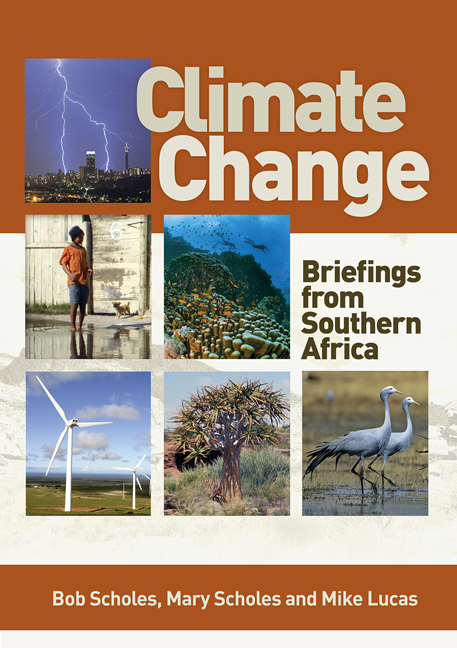Book contents
- Frontmatter
- Acknowledgements
- Contents
- Foreword
- Acronyms and abbreviations
- Preface
- How do governments assess climate change?
- Section 1 Earth system science: The processes that underlie climate change
- Section 2 Consequences of a changing climate for the Southern African environment
- Section 3 Consequences of a changing climate for society
- Section 4 What we can do to avoid and adapt to climate change
- Introduction
- 1 Is it cheaper to tolerate climate change or prevent it?
- 2 Is carbon trading desirable or useful?
- 3 Is it possible to take carbon dioxide out of the atmosphere?
- 4 Could fertilizing the oceans fix climate change?
- 5 Could we reduce incoming solar radiation?
- 6 Are there viable alternatives to coal for South Africa?
- 7 Can nuclear power provide the clean energy we need?
- 8 Can we turn garbage into energy?
- 9 Do biofuels offer a solution?
- 10 Could spekboom save our bacon?
- 11 Can we help plants and animals adapt to climate change?
- 12 Can we build climate-friendly houses and cities? 170
- 13 How can I reduce my carbon footprint? 173
- Codicil Is there a dangerous level of climate change?
- Glossary
- List of figures
- References
- Reading list
- Index
3 - Is it possible to take carbon dioxide out of the atmosphere?
from Section 4 - What we can do to avoid and adapt to climate change
Published online by Cambridge University Press: 20 April 2018
- Frontmatter
- Acknowledgements
- Contents
- Foreword
- Acronyms and abbreviations
- Preface
- How do governments assess climate change?
- Section 1 Earth system science: The processes that underlie climate change
- Section 2 Consequences of a changing climate for the Southern African environment
- Section 3 Consequences of a changing climate for society
- Section 4 What we can do to avoid and adapt to climate change
- Introduction
- 1 Is it cheaper to tolerate climate change or prevent it?
- 2 Is carbon trading desirable or useful?
- 3 Is it possible to take carbon dioxide out of the atmosphere?
- 4 Could fertilizing the oceans fix climate change?
- 5 Could we reduce incoming solar radiation?
- 6 Are there viable alternatives to coal for South Africa?
- 7 Can nuclear power provide the clean energy we need?
- 8 Can we turn garbage into energy?
- 9 Do biofuels offer a solution?
- 10 Could spekboom save our bacon?
- 11 Can we help plants and animals adapt to climate change?
- 12 Can we build climate-friendly houses and cities? 170
- 13 How can I reduce my carbon footprint? 173
- Codicil Is there a dangerous level of climate change?
- Glossary
- List of figures
- References
- Reading list
- Index
Summary
Yes it is, but it is slow, expensive, unproven at large scale and in most cases risky. It is better not to add carbon dioxide (CO2) to the atmosphere in the first place.
Carbon dioxide removal is one of two broad possible approaches to geo-engineering, that is, deliberate, large-scale interventions to cool Earth independently of reducing greenhouse gas emissions. The other main geo-engineering approach is to reduce solar radiation by reflecting it back into space (see Sec. 4, Q5). Both approaches remain speculative, and neither their effectiveness nor their risks have been seriously demonstrated at large scales. Most experts regard them as last-chance options in a climate emergency that cannot otherwise be solved, or where the political will to reduce emissions is found wanting or insufficient.
Carbon dioxide removal directly tackles one of the main causes of climate change – CO2 accumulation in the atmosphere – but, if implemented, it will take decades or even centuries to be effective. One of the simplest CO2 removal approaches is to plant trees and then ensure that the carbon stored in the wood does not find its way back into the atmosphere. To make an appreciable dent in the excess atmospheric CO2, afforestation would have to be at such a massive scale that food production, biodiversity and global water supplies would be adversely affected (see Sec. 4, Q10). Even if all former forests were restored, global CO2 concentrations would only fall by about 50 parts per million (ppm). Relative to the CO2 increase of about 120 ppm between the 1750s and 2014, this would help, but not nearly enough to solve the problem of global warming.
About a quarter of all CO2 emissions to the atmosphere are currently removed by the global oceans – but could human intervention encourage the oceans to do more? Phytoplankton production in some oceans is limited by insufficient nutrients. For example, large areas of the Southern Ocean are well supplied with most nutrients, but are short of iron. There and elsewhere, experimental additions of relatively small doses of dissolved iron to the ocean surface have increased phytoplankton growth, which takes up more CO2 due to increased photosynthesis. This process removes CO2 from the atmosphere, although only temporarily. When phytoplankton cells die, they sink and sequester CO2 in the deep ocean (below 1 000 m) for hundreds of years or more.
- Type
- Chapter
- Information
- Climate ChangeBriefings from Southern Africa, pp. 147 - 149Publisher: Wits University PressPrint publication year: 2015



